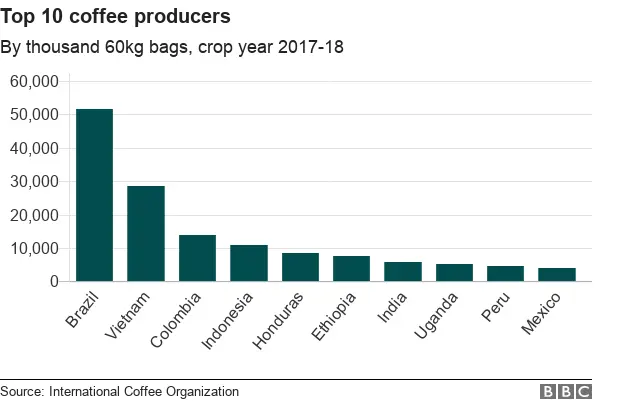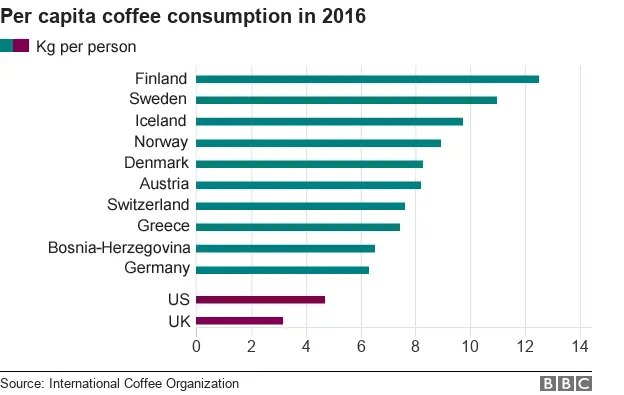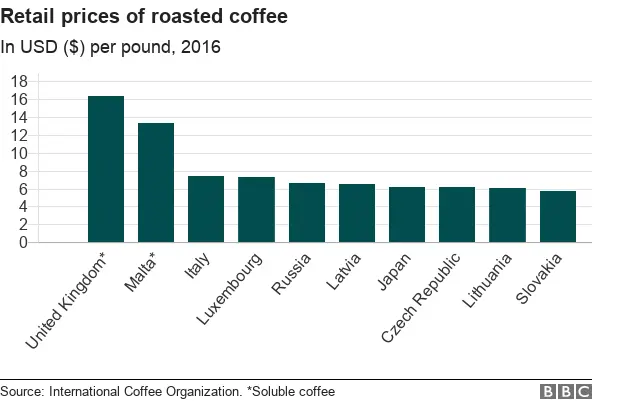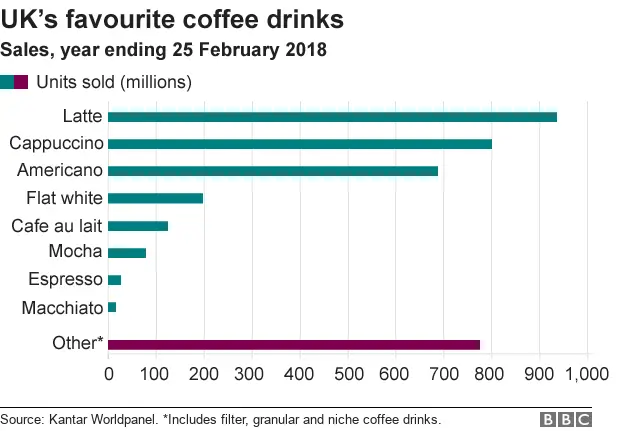Coffee: Who grows, drinks and pays the most?
 Getty Images
Getty ImagesHow do you like your coffee in the morning? From an Italian espresso to the Vietnamese ca phe trung, made with egg yolks and condensed milk, a lot depends on where you wake up.
More people are drinking more coffee than ever before, according to the UN's Food and Agriculture Organization. So which nation produces the most beans needed for our caffeine fix? Who drinks the most coffee, and where do people buy it?
1. Top coffee producers
Coffee is one of the world's most popular drinks, and it is produced in more than 50 countries.

Brazil is the world's largest coffee producer. In 2017-18, the country produced more than 51 million bags of beans. The world's second largest producer is Vietnam.
India, which is also one of the world's largest tea producers, produced 5.8 million 60kg bags of coffee in 2017-18, with neighbouring Sri Lanka producing 33,000.
Some much smaller countries are key producers. Honduras, for example, produced more than 8.3 million bags of coffee last year, and it is one of the country's top exports.
 Getty Images
Getty ImagesAccording to the Fairtrade Foundation, more than 125 million people around the world depend on coffee for their livelihoods, with around 25 million smallholder farms producing 80% of the world's coffee.
Fairtrade coffee means consumers can trace their coffee beans to find out exactly where they came from, and farmers are guaranteed a minimum price for their coffee. Fairtrade coffee farmers produce an estimated 560,900 tonnes of coffee a year - that's enough to make more than 58.9 billion single espressos.
Some academics argue that the scheme is expensive for farmers to join, and that could offset potential benefits. Encouraging coffee production with a cash incentive could also lead to too much coffee being produced, driving down prices.
However, Louisa Cox, director of impact at the Fairtrade Foundation, said that being fairtrade-certified also means that farmers can access training, safety equipment and protection.
Although there are more than 100 different coffee species, the most widely produced and sold are Arabica and Robusta.
2. Who drinks the most?
When it comes to coffee consumption, only two nations top more than 10kg per person per year - Finland and Sweden, according to statistics from the International Coffee Organization.
The Finnish drink the most coffee every year, at 12.5kg each.
Nordic countries also make up the rest of the top five, perhaps needing a cup to get through the cold days.

The world's top 10 coffee consuming nations are in Europe, whereas most of the largest coffee producers are in developing countries with the right weather to grow coffee.
The ideal conditions for growing coffee plants is found in the "bean belt" either side of the equator - between the Tropics of Capricorn and Cancer (23 degrees North to 23 degrees South).
Neither the US nor the UK makes the list of the top 20 coffee consumers, falling behind the likes of Croatia, France and Lithuania.
3. Who pays the most?
The coffee supply chain is complex. Beans pass hands from growers to traders, processors to exporters, and finally from roasters to retailers.
So a shift in the price of coffee can have big consequences on prices for farmers, producers and customers.
According to the International Coffee Organization, UK customers paid more than any others in 2016 - $16.29 (£11.45) per pound of soluble coffee.

This was followed by Malta at $13.33 (£9.37) and Italy at $7.45 (£5.24) per pound of roasted coffee.
Polish coffee-lovers paid the least for their daily fix of caffeine, at $3.17 (£2.23).
4. Biggest brands
Grabbing a cup of coffee on the way to the office has become a daily ritual for many workers around the world.
According to research group Allegra Strategies, there were more than 22,700 branded coffee shops in Europe in 2017, and more than 27,900 in the United States.

Seattle-based coffee company Starbucks comes out on top in the US with more than 13,500 outlets. Costa Coffee is the largest chain in Europe, with 2,755 coffee shops, followed by Starbucks with 2,406.
Although traditionally known as a nation of tea drinkers, the UK was home to 7,421 branded coffee shops in 2017.
The number of outlets in the UK grew by 643 last year, the biggest expansion in Europe.
5. Most popular coffee drinks
Coffee connoisseurs might pride themselves on their ability to drink the strong stuff, but the most popular coffee drinks purchased in the UK are milk-based.

Lattes were the most popular coffee product purchased in the UK, with more than 930 million sold in the year to 25 February 2018. Cappuccinos followed at 800 million, according to market researcher Kantar Worldpanel.
Flat whites are growing in popularity, with spend on the smooth coffee drinks increasing by 56% from February 2017 to 2018.
In total, people spent £6.3bn ($8.97bn) on coffee in the year to 25 February 2018.
Dwarfing the spend on tea in the UK in 2017 at just £1.5bn ($2.1bn), it seems that coffee culture is here to stay.
